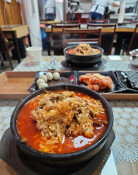Foreigners Abroad Not Included in National Image Survey
Foreigners Abroad Not Included in National Image Survey
Posted July. 09, 2007 03:03,
It was revealed that contrary to its initial purpose, the Korea Overseas Information Service (KOIS) under the Government Information Agency surveyed just Koreans and foreigners living in Korea on how well the national slogan Dynamic Korea is recognized among people.
Every year, the government has announced that the slogan Dynamic Korea is getting wider recognition in general based on those survey results.
The slogan Dynamic Korea is a catchphrase the government selected in December 2001, prior to the World Cup, to let the world know about Korea. To enhance our national image, the government launched the Korea Image Committee, headed by the prime minister, back in February 2005, and runs a team tasked with boosting the national image, and a global PR team to assist in this.
According to data released by Grand National Party (GNP) member Park Chan-sook yesterday, the KOIS advertised the Korean image abroad at the cost of 15 billion won (except 3.6 billion won spent on labor and other expenses), including the advertisement of the Dynamic Korea slogan in foreign media outlets, but it took a survey on the slogan among Koreans and foreigners living in Korea, not abroad.
In particular, the KOIS never conducted a survey of foreigners abroad.
The KOIS surveyed recognition of the national image slogan starting in 2004. The respondents were 1,000 Koreans and foreigners living in Korea, of whom, 700 were ordinary citizens, 200 were public servants, and 100 were foreigners.
Based on the result of the survey conducted at the end of 2005, the KOIS announced that compared to the results last year, slogan recognition rose from 29 percent to 40 percent (by 11 percentage points), and from 33.1 percent to 51.6 percent (by 18.5 percentage points) among foreigners and ordinary people, respectively.
Last year, the KOIS said that the slogan Dynamic Korea got higher recognition rates in New York and Los Angeles, with 60 percent and 63 percent, respectively, than in Korea (51.6 percent). However, some point out the fact that 400 Koreans participated in the surveys (200 in each city) and that a public relations officer passed around survey papers in person and conducted the survey personally, making the survey result less reliable.
When the Korea Tourism Organization (KTO) carried out a survey on 7,104 male and female foreigners about how well they know the slogan Dynamic Korea, only 22.4 percent of those surveyed said that they knew the slogan.
In particular, a mere 6.6 percent of those polled responded they knew the slogan in the North America region, and 93.4 percent of those surveyed said they didnt know the slogan. In Europe, just 10.5 percent of respondents said they knew the slogan, while 89.5 percent said they had no idea about the slogan.
The Culture and Tourism Committee pointed out last month in a report on the revenues and expenditures of Government Information Agency in 2006 that the KOIS wrongly selected the subject for the survey as it surveyed ordinary citizens, public servants for more than 90 percent of the total respondents, and that it failed to accurately asses the project efforts required for a better result.
The KOIS spent a net 2.6 billion won and 4.2 billion won in 2005 and 2006 on projects aimed at boosting the national image.
GNP member Park noted, It doesnt make sense to advertise the national image abroad and evaluate it at home, and added that the governments poor advertising is partly to blame for Pyeongchangs lost bid to host the 2014 Winter Olympics.
sys1201@donga.com
Headline News
- N. Korea blows up roads near border with S. Korea as tensions grow
- Samsung Galaxy S24 Ultra tops Consumer Reports’ best smartphone list
- Twin pandas Ruibao and Huibao meet the public for the first time
- Netanyahu decides to deploy retaliatory attack on Iran's military facilities
- Yang Ji-in named ISSF Athlete of the Year







